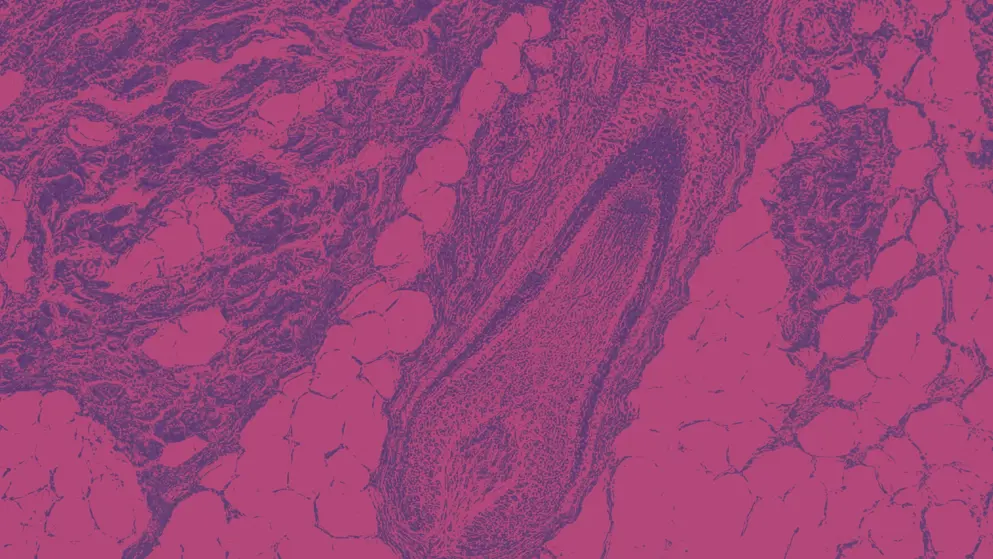
The future of alopecia areata
Unmet needs in alopecia areata treatment
At time of writing, there is no cure for alopecia areata (AA). There is a substantial unmet need for long-term, effective, and well-tolerated treatments to manage the most impactful symptom of this condition: hair loss. One indicator of this unmet need is the limited efficacy of current therapies for AA.1
In a survey of US dermatologists, their most common reasons for being dissatisfied with treatments for AA were:1
- Lack of treatment efficacy (73%)
- AA impacting patient quality of life (50%)
- Slow onset of action (37%)
- Patient not satisfied (33%)
They were most dissatisfied (just 17% satisfied) with treatment options for patients with severe AA, in part due to failed hair regrowth following treatment, and the numerous adverse impacts of AA on quality of life.1
For the more potent treatments, the most common sources of dissatisfaction were side effects, in the case of oral corticosteroids (40%), and patients disliking the mode of administration, in the case of immunomodulators (38%).1
Patient advocate Lynn Wilks provides her perspective on the unmet needs in alopecia areata and how those unmet needs have impacted her. View transcript.
Hear patient advocate Lynn Wilks’ perspective on how current practices around alopecia areata could be improved. View transcript.
Due in part to the underwhelming performance of most AA treatments, people with the condition are frequently switched between treatments due to poor response.1 New treatment development and ongoing clinical trials are informed by unmet needs and advances in our understanding of alopecia areata.1
References
- Fridman, 2022. Treatment patterns and treatment satisfaction among adults with alopecia areata in the United States. https://www.doi.org/10.1007/s12325-022-02338-4
The future of alopecia areata management
There is no cure for alopecia areata (AA), but there are a growing number of ways through which we may be able to address the most impactful symptom of this condition: hair loss. These include:
- A first-in-class small interfering (si)RNA treatment
- Advances in Janus kinase (JAK) inhibitors, including topical options
- Antibody-based therapeutics
Targeting the JAK–STAT pathway
JAK inhibitors are an established option for treating AA, with drugs like baricitinib and ritlecitinib approved for AA.1,2 At time of writing, upadacitinib, an oral selective JAK1 inhibitor, has shown good efficacy in treating AA and is currently under investigation as a potential future treatment option.3
Topical JAK inhibitors ruxolitinib and tofacitinib are also under development as potential future treatments for AA, but clinical trials and off-label studies to date have yielded mixed results.4
Risk remains an evolving issue in the JAK inhibitor space as further research is undertaken to better understand the relationship between JAK inhibitors and cardiac health / cancer risk.5
Another in-development treatment focused on the JAK–STAT pathway is ALY-101, which contains an siRNA designed to silence a specific gene.6,7 ALY-101 is an siRNA–lipid conjugate administered through intradermal injection into the scalp. It silences the JAK1 gene, reducing inflammation and potentially promoting hair regrowth.6,7
ALY-101 is currently undergoing testing in a phase 2a clinical trial and is intended as a long-acting option for AA requiring less frequent injections than existing options – just once every 4 weeks.6,7
A potential topical option
Coacillium, also known as cinainu, is a first-in-class topical derived from Theobroma cacao (cocoa tree), Allium cepa (onion), Citrus limon (lemon), and Paullinia cupana (guarana).8 It is marketed as a consumer hair-care product and, in the recently completed phase 2/3 clinical trial RAAINBOW, it resulted in a 30.87% improvement in SALT score versus placebo during 24 weeks of treatment in children and adolescents with moderate-to-severe AA.8-10
To date, coacillium has failed to receive a positive opinion from the European Medicines Agency’s Committee for Medicinal Products for Human Use, due primarily to concerns about quality. This led to the withdrawal of the application by the manufacturer, and the future of coacillium/cinainu remains uncertain at time of writing.11
New approaches in immunotherapy
Itaconate is an indigenous immunomodulator that has notable anti-inflammatory effects and shows therapeutic potential across a number of disease models.12,13 However, it has poor cellular permeability.12,13
A solution to this may come in the form of SCD-153, a topical prodrug that forms the itaconate derivative 4-methyl itaconate (4MI) upon penetrating the outermost layer of the epidermis.12 Preclinical studies of SCD-153 have shown the potential of 4MI and other itaconate derivatives to induce hair growth.12
Orally available itaconate-derivative prodrugs are currently in the early stages of development, with preclinical research showing this oral option to have a significant anti-inflammatory effect.13
An alternative emerging immunotherapeutic option, bempikibart is a human anti-IL-7Rα antibody that is designed to modulate immune function by inhibiting both interleukin-7 (IL-7) and thymic stromal lymphopoietin (TSLP) signaling. Bempikibart is currently being investigated in the phase 2a clinical trial SIGNAL-AA, a multi-center proof-of-concept trial. Early data suggest a significant effect at a dose of 200 mg every 2 weeks for 24 weeks, which persisted after treatment withdrawal.14
Bempikibart for AA was granted fast-track designation by the FDA in April 2025.
Continue learning about alopecia areata?
Hear a patient’s perspective on contemporary treatment with this in-depth interview of patient advocate Lynn Wilks, focusing on her lived experience with alopecia areata.
References
- Freitas, 2023. Baricitinib for the treatment of alopecia areata. https://www.doi.org/10.1007/s40265-023-01873-w
- Blair, 2023. Ritlecitinib: First approval. https://www.doi.org/10.1007/s40265-023-01928-y
- Stirrat, 2025. Upadacitinib for alopecia: Current evidence and clinical insights. https://www.doi.org/10.1159/000544868
- King and Craiglow, 2023. Janus kinase inhibitors for alopecia areata. https://www.doi.org/10.1016/j.jaad.2023.05.049
- Nash, 2025. Expert consensus statement on the treatment of immune-mediated inflammatory diseases with Janus kinase inhibitors: 2024 update. https://www.doi.org/10.1016/j.ard.2025.01.032
- Fessenden, 2025. Clinical trial participant receives first dose of UMass Chan-developed treatment for alopecia areata by Alys Pharmaceuticals. https://www.umassmed.edu/news/news-archives/2025/05/clinical-trial-participant-receives-first-dose-of-umass-chan-developed-treatment-for-alopecia-areata-by-alys-pharmaceuticals/
- ClinicalTrials.gov. 2025. A clinical study to evaluate the safety, tolerability, pharmacokinetics and preliminary efficacy of ALD-102 solution in subjects with alopecia areata. https://clinicaltrials.gov/study/NCT06826196
- Patsner and Harti, 2020. A botanical compound for the treatment of alopecia areata and chemotherapy-induced alopecia. https://www.doi.org/10.1016/j.jisp.2020.04.009
- Spring, 2023. Botanical extract coacillium for management of paediatric atopic dermatitis: A case report. https://www.doi.org/10.2340/actadv.v103.13376
- Blume-Peytavi, 2024. Oral abstracts. https://www.doi.org/10.1111/pde.15584
- EMA. 2025. Cinainu. https://www.ema.europa.eu/en/medicines/human/EPAR/cinainu#all-documents
- Tsai, 2023. Topical SCD-153, a 4-methyl itaconate prodrug, for the treatment of alopecia areata. https://www.doi.org/10.1093/pnasnexus/pgac297
- Lee, 2025. Discovery of orally available prodrugs of Itaconate and derivatives. https://www.doi.org/10.1021/acs.jmedchem.4c02646
- Fraser, 2025. American Academy of Dermatology Annual Meeting: Orlando, FL, USA, 7-11 March 2025. https://www.doi.org/10.1007/s40257-025-00945-9
of interest
are looking at
saved
next event
Developed by EPG Health. This content has been developed independently of the sponsor, Pfizer, who has reviewed the content only for scientific accuracy. EPG Health received funding from the sponsor in order to help provide healthcare professionals with access to the highest quality medical and scientific information, education and associated relevant content.



